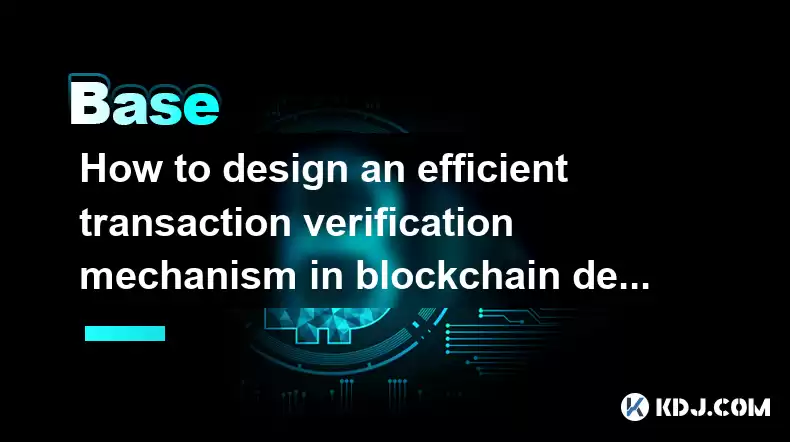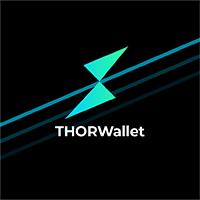-
 bitcoin
bitcoin $100977.009184 USD
-2.05% -
 ethereum
ethereum $3282.009150 USD
-3.23% -
 tether
tether $0.999813 USD
-0.02% -
 xrp
xrp $2.208254 USD
-4.89% -
 bnb
bnb $951.411089 USD
0.55% -
 solana
solana $155.761205 USD
-2.84% -
 usd-coin
usd-coin $1.000217 USD
0.02% -
 tron
tron $0.284475 USD
-1.28% -
 dogecoin
dogecoin $0.162363 USD
-1.53% -
 cardano
cardano $0.533988 USD
-0.47% -
 hyperliquid
hyperliquid $39.174339 USD
-3.22% -
 chainlink
chainlink $14.724828 USD
-1.16% -
 bitcoin-cash
bitcoin-cash $477.297986 USD
-1.28% -
 zcash
zcash $554.227426 USD
17.30% -
 ethena-usde
ethena-usde $0.998995 USD
-0.03%
How to design an efficient transaction verification mechanism in blockchain development?
Efficient blockchain transaction verification prioritizes speed, cost, and security, leveraging techniques like PoS consensus, optimized Merkle trees, sharding, lightweight clients, and robust security protocols to balance performance with resilience against attacks.
Mar 07, 2025 at 02:24 am

- Defining Transaction Efficiency in Blockchain: Focuses on speed, cost, and security.
- Consensus Mechanisms and their impact on verification speed.
- Data Structures: Optimizing Merkle Trees and other data structures for faster verification.
- Sharding and Parallel Processing: Distributing the workload for faster transaction processing.
- Lightweight Clients and Proof of Verification: Reducing the computational burden on nodes.
- Security considerations: Balancing speed with robust security against double-spending and other attacks.
- Practical implementation challenges: Scalability, interoperability, and maintaining decentralization.
Designing an efficient transaction verification mechanism is crucial for the scalability and usability of any blockchain. Efficiency in this context encompasses speed, cost, and security. A slow or expensive verification process hinders adoption, while a vulnerable mechanism jeopardizes the entire system. This article explores key strategies for achieving efficiency.
First, we must define what constitutes an "efficient" transaction verification mechanism. It should process transactions quickly, minimizing latency between submission and confirmation. The cost, in terms of computational resources and energy consumption, should be low for both individual nodes and the network as a whole. Finally, and critically, the mechanism must be secure, resistant to attacks like double-spending and 51% attacks.
The choice of consensus mechanism significantly impacts verification efficiency. Proof-of-Work (PoW) systems, while secure, are notoriously slow due to the computational intensity of mining. Proof-of-Stake (PoS) mechanisms, on the other hand, generally offer faster transaction confirmation times due to their reduced energy consumption and reliance on validators rather than miners. Other consensus mechanisms like Delegated Proof-of-Stake (DPoS) and Practical Byzantine Fault Tolerance (PBFT) also provide varying degrees of speed and security trade-offs.
Efficient data structures are paramount. Blockchain relies heavily on Merkle trees to efficiently verify large sets of transactions. Optimizing Merkle tree construction and traversal algorithms can drastically improve verification speed. Furthermore, exploring alternative data structures tailored to specific blockchain needs can further enhance efficiency. Consider the use of Bloom filters for faster data lookups.
Sharding, a technique that partitions the blockchain into smaller, more manageable pieces, is a powerful tool for improving scalability and transaction verification speed. By distributing the workload across multiple shards, the network can process transactions in parallel, significantly reducing overall latency. However, careful design is needed to ensure data consistency and security across shards.
Lightweight clients are designed to verify transactions without downloading the entire blockchain. They rely on simplified verification methods, such as relying on trusted sources for block headers, significantly reducing computational overhead for individual users. This improves accessibility and efficiency for users with limited resources. Proofs of verification, cryptographic techniques that allow verification without full data access, are also relevant here.
Security remains paramount. While optimizing for speed, it's crucial to maintain robust security against various attacks. This includes measures to prevent double-spending, replay attacks, and Sybil attacks. The chosen consensus mechanism and cryptographic algorithms directly influence the system's security. A trade-off often exists between speed and security; careful design balances these competing needs.
Implementing these strategies presents practical challenges. Scalability remains a significant hurdle, as even with optimizations, transaction throughput can become a bottleneck with increasing network usage. Interoperability with other blockchains is another challenge, requiring standardized protocols and data formats. Finally, maintaining decentralization while improving efficiency is a delicate balancing act. Over-centralization can compromise the fundamental principles of blockchain technology.
Frequently Asked Questions:Q: What are the major bottlenecks in blockchain transaction verification?A: Major bottlenecks include the consensus mechanism's speed, the computational cost of verifying transactions (especially with large block sizes), network latency, and the need to maintain data consistency across the entire network.
Q: How does sharding improve transaction verification efficiency?A: Sharding divides the blockchain into smaller shards, allowing parallel processing of transactions. This drastically reduces the workload on individual nodes, leading to faster verification times and increased throughput.
Q: What are the security implications of using lightweight clients?A: Lightweight clients rely on trusted sources for information, introducing a degree of trust that compromises the fully decentralized nature of the system. Careful selection of trusted sources and mechanisms to detect malicious behavior are crucial.
Q: Can different consensus mechanisms be combined for improved efficiency?A: Yes, hybrid approaches combining the strengths of different consensus mechanisms are being explored. For example, a system might use a fast consensus mechanism for everyday transactions and a more secure, slower mechanism for high-value or critical transactions.
Q: How can we balance speed and security in transaction verification?A: This involves careful selection of algorithms, cryptographic primitives, and consensus mechanisms. It often involves a trade-off; faster mechanisms might sacrifice some security, while highly secure ones might be slower. Thorough security audits and rigorous testing are crucial.
Disclaimer:info@kdj.com
The information provided is not trading advice. kdj.com does not assume any responsibility for any investments made based on the information provided in this article. Cryptocurrencies are highly volatile and it is highly recommended that you invest with caution after thorough research!
If you believe that the content used on this website infringes your copyright, please contact us immediately (info@kdj.com) and we will delete it promptly.
- BlockDAG, Avalanche, Dogecoin: Crypto's Leading Trio in 2025
- 2025-11-07 22:05:01
- Layer 2 Coins: Will There Be a Potential Explosion by 2026?
- 2025-11-07 16:50:02
- Filecoin, ICP, and the AI Infrastructure Renaissance: Is History Repeating?
- 2025-11-07 16:50:02
- Bitcoin's Wild Ride: Surges, Zeros, and the Search for Stability
- 2025-11-07 17:05:01
- XRP, Bitcoin, and the Rally: What's the Deal, New York?
- 2025-11-07 17:25:01
- Filecoin, DePIN, and a Technical Breakout: What's the Buzz?
- 2025-11-07 17:05:01
Related knowledge

What is liquid restaking and how does it build upon the concept of staking?
Nov 07,2025 at 06:19pm
Bitcoin’s Role in Decentralized Finance Evolution1. Bitcoin remains the cornerstone of decentralized finance, setting benchmarks for security and netw...

What is a concentrated liquidity position and how does it improve capital efficiency?
Nov 07,2025 at 06:00pm
Understanding Concentrated Liquidity Positions1. A concentrated liquidity position allows liquidity providers to allocate their capital within a speci...

What is an initial DEX offering (IDO) and how do you participate?
Nov 07,2025 at 06:59pm
Understanding Initial DEX Offerings (IDOs)1. An initial DEX offering (IDO) is a fundraising mechanism used by blockchain projects to launch their toke...

What is a double-spend problem and how does blockchain solve it?
Nov 07,2025 at 05:19pm
Understanding the Double-Spend Problem1. The double-spend problem refers to a scenario in digital currencies where the same set of funds is spent more...

What is a Play-to-Earn (P2E) game and how do players earn real money?
Nov 07,2025 at 09:00pm
Understanding Play-to-Earn (P2E) Gaming1. Play-to-Earn (P2E) games are blockchain-based video games that allow players to earn cryptocurrency or non-f...

What is a crypto mixer or tumbler and how does it obscure transaction history?
Nov 07,2025 at 06:39pm
Understanding Crypto Mixers and Their Role in Transaction PrivacyA crypto mixer, also known as a tumbler, is a service designed to obscure the traceab...

What is liquid restaking and how does it build upon the concept of staking?
Nov 07,2025 at 06:19pm
Bitcoin’s Role in Decentralized Finance Evolution1. Bitcoin remains the cornerstone of decentralized finance, setting benchmarks for security and netw...

What is a concentrated liquidity position and how does it improve capital efficiency?
Nov 07,2025 at 06:00pm
Understanding Concentrated Liquidity Positions1. A concentrated liquidity position allows liquidity providers to allocate their capital within a speci...

What is an initial DEX offering (IDO) and how do you participate?
Nov 07,2025 at 06:59pm
Understanding Initial DEX Offerings (IDOs)1. An initial DEX offering (IDO) is a fundraising mechanism used by blockchain projects to launch their toke...

What is a double-spend problem and how does blockchain solve it?
Nov 07,2025 at 05:19pm
Understanding the Double-Spend Problem1. The double-spend problem refers to a scenario in digital currencies where the same set of funds is spent more...

What is a Play-to-Earn (P2E) game and how do players earn real money?
Nov 07,2025 at 09:00pm
Understanding Play-to-Earn (P2E) Gaming1. Play-to-Earn (P2E) games are blockchain-based video games that allow players to earn cryptocurrency or non-f...

What is a crypto mixer or tumbler and how does it obscure transaction history?
Nov 07,2025 at 06:39pm
Understanding Crypto Mixers and Their Role in Transaction PrivacyA crypto mixer, also known as a tumbler, is a service designed to obscure the traceab...
See all articles





















![The Graph Price Prediction [GRT Crypto Price News Today] The Graph Price Prediction [GRT Crypto Price News Today]](/uploads/2025/11/07/cryptocurrencies-news/videos/690d4df44fe69_image_500_375.webp)




















































